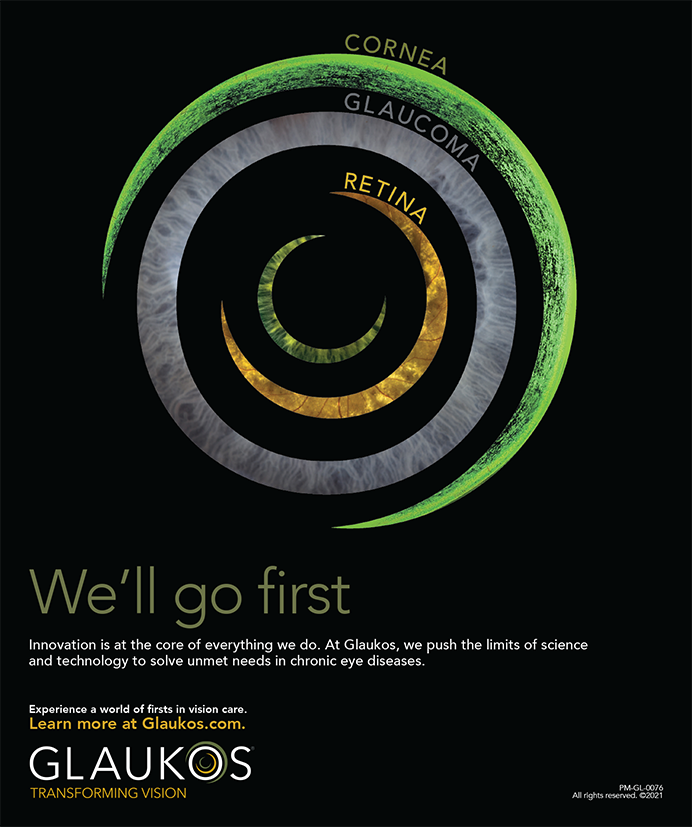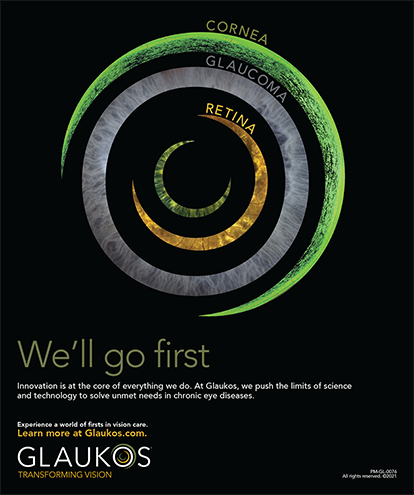CASE PRESENTATION
You are finishing cataract surgery. After removing all of the cortical material, you discover a tear in the anterior capsule, most likely from its being struck by the phaco needle (Figure 1). The posterior capsule is intact. You had planned to implant a single-piece acrylic toric IOL.
Would you go ahead and place this IOL in the bag as planned and discussed with the patient, or would you implant a different IOL? If the former, will it matter where the tear in the capsule is relative to the desired final location of the lens? If you would implant an alternative lens, what type of IOL would you choose, and where would you place it?
MARIA M. AARON, MD
In this case, I would favor a conservative approach and place a single-piece acrylic IOL in the bag. Reasonable, predictive options for correcting astigmatism are available postoperatively, and the stability of a toric IOL in the setting of an anterior radial capsular tear (ART) is currently unknown.
The placement of a toric IOL in this case raises several concerns. First, there is the possibility of an unpredictable refractive outcome from movement of the IOL, either rotational or displacement from the capsular bag. In addition, excessive manipulation of the toric IOL into the appropriate position might cause the ART to extend posteriorly, requiring a vitrectomy and possibly replacement of the toric IOL with a sulcus-fixated lens. Finally, an IOL placed in the bag should be 90º away from the ART, and it would be highly unlikely that the radial tear would occur 90º away from the axis of astigmatism.
Postoperatively, I would discuss contact lenses and refractive surgery with the patient as reasonable options for correcting his or her residual refractive error. When patients expect excellent UCVA after cataract surgery, I feel that it is critical to know if they are candidates for refractive surgery and to discuss this possibility with them prior to performing the cataract procedure.
SHERLEEN CHEN, MD
The two primary issues are the safe implantation and the stability of the IOL. I would explore under the iris with a Kuglen hook to determine the extent of the capsular defect. If a complete bite from the phaco tip were visible, then the capsular situation would be stable. I would therefore implant the toric lens unless the end of one of its haptics had to lie in the axis of the defect. If exploration revealed an ART, I would abandon the toric lens. The stability of such IOLs is crucial to their success, and incomplete capsular overlap of the optic potentiates instability. Furthermore, the placement of a toric lens requires additional manipulation to ensure precise axial alignment and complete removal of the viscoelastic to prevent rotation of the IOL. These maneuvers might destabilize the situation. Marques and colleagues previously reported that six of 14 (42.8%) ARTs actually extended posteriorly during implantation of the IOL.1
Placing a three-piece IOL designed for the sulcus is the option least likely to cause a posterior extension of the tear. In this case, however, it would not be possible to capture the optic posteriorly, and the capsular bag would provide a more stable and physiologic location. Thus, I would proceed with endocapsular implantation of the IOL, while carefully avoiding overdistension of or excess tension on the capsular bag for the remainder of the case. I would select a single-piece acrylic lens, owing to its gentle delivery, and I would orient the haptics 90º from the tear before they unfolded. To remove the viscoelastic, I would lower the bottle and use bimanual I/A. I would inject intracameral acetylcholine to ensure a round pupil without vitreous prolapse.
Residual astigmatism could be addressed with limbal relaxing incisions or laser vision correction postoperatively. Preoperatively, I would have explained to the patient that a toric IOL would be implanted only under ideal conditions.
JAMES A. DAVISON, MDM
In the early 1980s, surgeons often noticed ARTs that extended to the equator of the capsular bag after phacoemulsification. fluidics that enable continued phacoemulsification during occlusion of the tip had not yet been invented. The emulsate dust was therefore simply aspirated into the tip, as it shaved away the anteriorly prolapsed nucleus during surgery (Figure 2). The commonly seen (78% of cases), single, subincisional ART was almost thought to be a necessary relaxing incision to facilitate the anteriorprolapse maneuver.2 At that time, most PCIOLs featured polypropylene modified-J-shaped haptics with an overall length of 13.5 mm. Adequate fixation and centration of the optic could be accomplished in cases of asymmetric bag-sulcus fixation or in the ciliary sulcus as well as within the capsular bag. Because they did not bridge ARTs well, the haptics were usually oriented 90º away from the tear during capsular bag fixation (Figures 3 and 4).
The introduction of the single-piece AcrySof IOL platform (Alcon Laboratories, Inc., Fort Worth, TX) in 2000 improved capsular bag fixation in all cases, including those in which an ART might have occurred. Better fixation and centration of the optic are due to the friction provided by the surface area of the square 0.4- X 0.4-mm C-shaped haptic architecture, its low resistance to compression, and the flexibility and memory of the AcrySof acrylic plastic.3 That consistent bag-haptic relationship created the basis for the rotational stability of the AcrySof Toric IOL (Alcon Laboratories, Inc.).
On multiple occasions, I have placed the single-piece AcrySof IOL in capsular bags with one ART, and I have not observed any postoperative rotation of the IOL. In only one instance have I encountered an ART during surgery when I intended to implant an AcrySof Toric IOL. In that case, the toric IOL was placed as usual, remained in its appropriate position after surgery, and achieved the anticipated reduction in refractive cylinder (Figures 5-8). Because the broad C-shaped haptic can easily bridge an ART at the equator, the toric IOL can be placed in any orientation with respect to the tear, as long as the haptic is under both flaps of the anterior capsular remnant. Special attention should be given to removing the viscoelastic as completely as possible, both anterior and posterior to the optic and in the peripheral capsular bag, just as in cases without an ART.
Rarely, single-piece AcrySof Toric IOLs have been shown to rotate within intact capsular bags after surgery,4 especially in large eyes requiring low-powered IOLs.5 Surgical reorientation of these IOLs has been easily accomplished and successful, but it could be more difficult in eyes with ARTs.
A. TIM JOHNSON, MD, PHD
I have seen radial tears produced in the capsulorhexis from a variety of causes, including
- peripheral extension during the performance of the capsulorhexis
- rupture of the capsulorhexis during hydrodissection
- damage to the capsule from phacoemulsification or the I/A handpiece
- placement of a horizontal chopper over the capsule rather than under it
- pulling of large nuclear pieces or prolapse
Prior to the advent of single-piece acrylic lenses, I was not comfortable placing three-piece lenses within the capsular bag. Their relatively stiff haptics could extend the tear posteriorly. Even if the lens were implanted in the bag without damage, asymmetric contraction often caused late decentration.
The softer haptics of the single-piece acrylic lens make implanting the IOL in the bag much safer. I no longer hesitate to do so and have not seen an extension of the tear or late decentration of the lens. That said, a patient’s expectations are usually much higher when he or she has chosen a premium IOL. Although the lens is not likely to move, even a small change could reduce its toric effect. The radial tear would also complicate surgery to reposition or exchange the implant.
In this case, I would place a standard single-piece acrylic implant in the bag. I would address the astigmatism by treating the cornea (either with relaxing incisions or laser correction) at a later date. It is always important to discuss with the patient prior to surgery the possibility of not using a toric implant.
KEVIN M. MILLER, MD
This is an unfortunate event, but it should still be possible to obtain a good astigmatic result.
I would polish the anterior capsule using a pair of Shepherd-Rentsch capsule polishers. I would fill the capsular bag with an ophthalmic viscosurgical device and inject the planned single-piece toric acrylic lens. After orienting the lens in the proper meridian, completely removing the ophthalmic viscosurgical device, and closing the incisions, I would assess the centration and rotational stability of the lens. The location of ARTs is relatively unimportant with single-piece acrylic lenses, as long as the tears do not extend posteriorly. In my experience, if a toric lens is well positioned when the incision is closed and the capsule is well polished, the IOL will remain that way for the rest of the patient’s life.
If the toric lens tended to decenter or rotate, and I could not adjust it to stay in the correct position, I would remove it and replace it with a spherical lens. My choice of a replacement lens would depend on the issues associated with the toric lens. If it tended to decenter, I would implant a three-piece AQ2010V IOL (STAAR Surgical Company, Monrovia, CA) in the ciliary sulcus. If the toric lens were rotationally unstable but centered well in the capsular bag, I would place a spherical single-piece acrylic lens in the bag. Regardless, I would correct the patient’s astigmatism with peripheral corneal relaxing incisions.
I would bet a Coke that this case could be finished with the planned toric lens implant.
Section editor Bonnie A. Henderson, MD, is a partner in Ophthalmic Consultants of Boston and an assistant clinical professor at Harvard Medical School. Thomas A. Oetting, MS, MD, is a clinical professor at the University of Iowa in Iowa City. Tal Raviv, MD, is an attending cornea and refractive surgeon at the New York Eye and Ear Infirmary and an assistant professor of ophthalmology at New York Medical College in Valhalla. Dr. Oetting may be reached at (319) 384-9958; thomas-oetting@uiowa.edu.
Maria M. Aaron, MD, is an associate professor of ophthalmology and residency program director at Emory Eye Center in Atlanta. Dr. Aaron may be reached at (404) 778-5431; mmendic@emory.edu.
Sherleen Chen, MD, is the director of comprehensive ophthalmology at the Massachusetts Eye and Ear Infirmary, and she is an instructor in ophthalmology at Harvard Medical School, both in Boston. Dr. Chen may be reached at (617) 573-3202; sherleen_chen@meei.harvard.edu.
James A. Davison, MD, is the board chairman at Wolfe Eye Clinic in Marshalltown, Iowa. He is a paid consultant to Alcon Laboratories, Inc. Dr. Davison may be reached at jdavison@wolfeclinic.com.
A. Tim Johnson, MD, PhD, is a professor of clinical ophthalmology in the Department of Ophthalmology and Visual Sciences at the University of Iowa in Iowa City. Dr. Johnson may be reached at (319) 353-7955; a-tim-johnson@uiowa.edu.
Kevin M. Miller, MD, is the Kolokotrones professor of clinical ophthalmology at the Jules Stein Eye Institute, David Geffen School of Medicine at UCLA, Los Angeles. He was an investigator in the Alcon Toric IOL trial, and he is a consultant to Alcon Laboratories, Inc.; Hoya Surgical Optics, Inc.; and STAAR Surgical Company. Dr. Miller may be reached at (310) 206-9551; kmiller@ucla.edu.
- Marques FF,Marques DMV,Osher RH,Osher JM.Fate of anterior capsule tears during cataract surgery.J Cataract Refract Surg.2006;32(10):1638-1642.
- Davison JA.Analysis of capsular bag defects and intraocular lens positions for consistent centration.J Cataract Refract Surg.1986;12.
- Lane SS,Burgi P,et al.Comparison of the biomechanical behavior of foldable intraocular lenses. J Cataract Refract Surg.2004;30:2397-2402.
- Chang DF.Comparative rotational stability of single-piece open-loop acrylic and plate-haptic silicone toric intraocular lenses.J Cataract Refract Surg.2008;34:1842-1847.
- Davison JA,Weinstein AJ.Three strategies for reorienting AcrySof Toric IOLs.Cataract & Refractive Surgery Today. March 2010;10(3):27-30.


